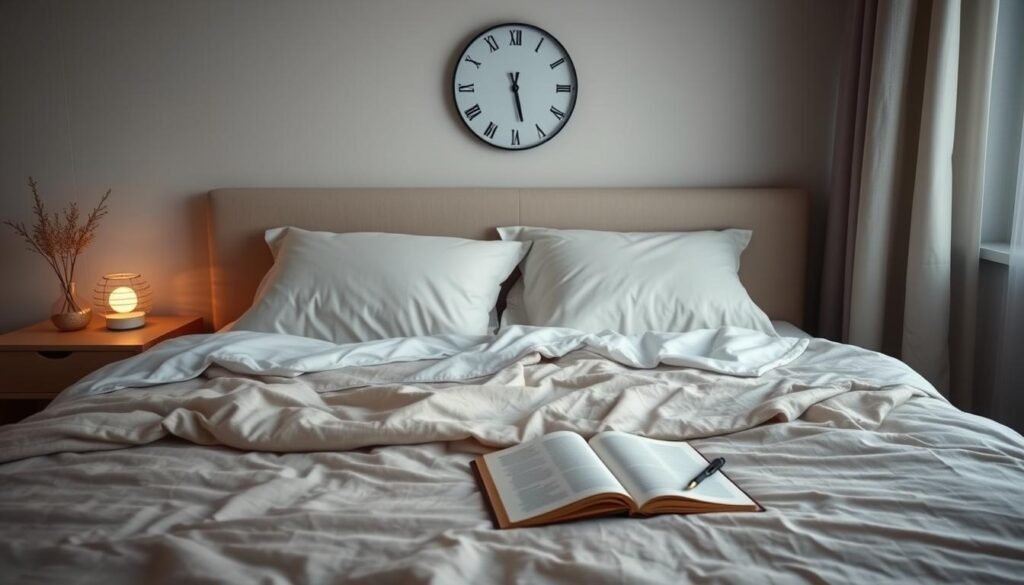Chronic insomnia impacts 6-10% of adults, leading to major life disruptions. Many seek effective treatments to regain sleep control. Sleep restriction therapy, a cognitive method, aims to boost sleep by reducing bed time. This guide will shed light on sleep restriction’s benefits for insomnia, aiming for improved rest and vitality.
Key Takeaways
- Chronic insomnia affects 6-10% of the population.
- Sleep Restriction Therapy aims to improve sleep efficiency by limiting time in bed.
- This therapy can lead to significant improvements in sleep quality.
- Improved sleep patterns contribute to better daily functioning.
- Consulting a healthcare provider is vital before starting any therapy.
Understanding Insomnia and Its Impact
Insomnia disorder touches many lives around the globe. It difficulties sleeping and causes sleep deprivation. People with insomnia may have problems falling asleep, staying asleep, or wake up too early. These issues can affect daily life and well-being.
Defining Insomnia
Insomnia involves issues with starting or keeping sleep. It can be short-term or long-lasting. Insomnia is more than just missing sleep. It can harm a person’s physical health, mental state, and how they think. Knowing how widespread insomnia is and its signs is key to treating it.
Causes of Insomnia
Several factors lead to insomnia, including:
- Stress and anxiety
- Medical issues like chronic pain or breathing problems
- Mental health problems such as depression
- Some medicines or substances
- Poor habits around sleep
Dealing with these causes is vital in tackling insomnia. Good treatment improves sleep and reduces its negative effects on daily life. Without managing it, chronic insomnia might cause serious health issues.
| Cause | Description |
|---|---|
| Stress | Situations that bring more tension or worry, disrupting sleep. |
| Medical Conditions | Health issues making it hard to keep sleep steady. |
| Mental Health Disorders | Problems like depression that alter mood and sleep quality. |
| Medications | Some medicines might have effects that make sleeping tough. |
| Poor Sleep Hygiene | Bad sleep habits and places that don’t help in sleeping. |
What is Sleep Restriction Therapy?
Sleep Restriction Therapy (SRT) is a technique used to help people with insomnia. It limits how long you stay in bed. The goal is to match your time in bed with how much sleep you really need. This helps you fall asleep faster and sleep better.
Overview of Sleep Restriction
The main goal of sleep restriction is to find the right amount of sleep for you. You use a sleep diary to track your sleep. This helps you and your doctors figure out the best sleep schedule. It cuts the time it takes you to fall asleep.
How Sleep Restriction Works
At the start, you might feel more tired during the day. This is because your body is getting used to a new sleep schedule. You’ll keep to a strict bedtime, not sleeping less than 5.5 hours, no matter what.
Over time, as your sleep improves, you can stay in bed longer. This happens in small steps, like adding 15 minutes more per week. SRT has been shown to fix wrong beliefs about sleep. It also makes your sleep quality better, as noted in sleep diaries.

| Study | Findings |
|---|---|
| 2020 study | SRT more effective for individuals with short-duration insomnia |
| 2019 meta-analysis | SRT improved insomnia severity and increased time asleep in the short term |
| Study on postmenopausal women | Improved quality of life and increased productivity |
| Review of multiple studies | All studies showed reduced restless time in bed and quicker sleep onset |
Sleep Restriction for Insomnia: A Step-by-Step Approach
Starting sleep restriction therapy involves identifying your sleep window first. This means finding the best time frame for restorative sleep. Next, a steady sleep schedule is made. It’s key to better sleep and fighting insomnia.
Identifying Your Sleep Window
First, track your sleep to see how much you actually get. This helps find your sleep window. By limiting time in bed to this window, you train your brain. This improves sleep quality.
Setting a Consistent Sleep Schedule
Being consistent is crucial with sleep restriction therapy. A set bedtime and wake time creates a routine. Your body will get used to this routine over time. Sticking to this schedule strengthens your natural sleep cycle. It makes your sleep more efficient, letting you rest well and stay alert during the day.

Benefits of Sleep Restriction Therapy
Sleep restriction therapy (SRT) has many benefits for those dealing with insomnia. Studies say that SRT helps improve sleep quality and efficiency. By limiting sleep time, people tend to fall asleep faster and enjoy a deeper sleep. This method builds a healthy sleep cycle without needing drugs.
Improved Sleep Quality
SRT makes the bed more associated with sleep, helping those with insomnia. Research shows it reduces negative thinking and depression. These changes lead to better sleep quality. People feel happier with their sleep, which boosts mood and lowers tiredness during the day.
Enhanced Sleep Efficiency
Sleep restriction therapy also improves sleep efficiency. It helps people sleep continuously without waking up. A study found that improving sleep efficiency leads to longer sleep times. Committing to SRT for two to eight weeks can significantly improve sleep and overall health.
For deeper insights on SRT’s benefits, check out this detailed study on sleep restriction therapy.

Safety Considerations and Managing Sleep Deprivation
Before starting sleep restriction therapy, it’s crucial to talk to a health care provider. This is particularly important for those with existing medical issues. Getting the right advice ensures the therapy is safe and suited to your health needs.
Consulting a Health Care Provider
Talking to a health care provider is key. They customize sleep deprivation therapy to fit your specific situation. This helps lower risks tied to changing your sleep patterns, like feeling more tired during the day. Your provider will guide you in handling these changes and recommend the best treatment.
Understanding Potential Initial Risks
Changing your sleep schedule can initially make you feel more tired. It’s important to watch these signs and talk to your health care provider about them. Doing this helps make the shift to a healthier sleep routine smoother. It lets you get the most out of your therapy.
| Medication Type | Examples | Notes |
|---|---|---|
| Benzodiazepines | Estazolam, Temazepam | Effective but may cause dependence and tolerance. |
| Z-Drugs | Zaleplon, Zolpidem | Short-term use recommended due to side effects. |
| Dual Orexin Receptor Antagonists | Suvorexant | Regulates sleep-wake cycles. |
| Sedating Antidepressants | Doxepin, Trazodone | Useful for individuals with co-occurring conditions. |
| Melatonin-Based | Ramelteon | Available by prescription and over-the-counter. |
Effective therapies and medications can greatly improve life for someone with insomnia. Staying careful about safety and working with a health care provider makes improving sleep easier. To learn more about insomnia treatments, click here.
Complementary Techniques to Enhance Sleep Quality
Using different techniques can make sleep better for people dealing with insomnia. By combining good sleep habits with other methods, we create a plan to fight sleep problems.
Incorporating Sleep Hygiene Practices
Good sleep habits are key to sleeping better. They include practices that make a restful sleep environment:
- Keeping a consistent sleep schedule: Going to bed and waking up at the same time every day helps regulate the body’s internal clock.
- Creating a sleep-friendly environment: Reducing noise and light can create a calming atmosphere, promoting relaxation before sleep.
- Minimizing caffeine and alcohol intake: Both substances can interfere with sleep patterns when consumed in excess or close to bedtime.
Along with sleep hygiene, relaxation practices can improve sleep quality and reduce anxiety. Techniques like deep breathing and muscle relaxation reduce stress. This makes it easier to sleep. It’s important to understand these practices to better sleep quality.
Integrating Cognitive Behavioral Therapy for Insomnia (CBT-I)
Cognitive behavioral therapy for insomnia is a top method for changing sleep behaviors. CBT-I tackles the cognitive and behavioral aspects contributing to sleep issues. Techniques include:
- Stimulus control: This method helps you link the bed to sleep. It limits activities like reading or screen use in bed.
- Cognitive restructuring: This means changing negative thoughts about sleep to positive ones.
Studies show that CBT-I can work as well as or better than sleep meds. Combining CBT-I with good sleep habits can really help fight insomnia. For more on behaviors that affect sleep, check out this source.
| Technique | Description | Benefits |
|---|---|---|
| Sleep Hygiene | Practices to create a conducive sleeping environment | Improved sleep quality and routine |
| Breathing Exercises | Techniques to reduce anxiety and stress | Enhanced relaxation and readiness for sleep |
| CBT-I | Cognitive and behavioral techniques to alter sleep thoughts | Long-lasting improvement in sleep patterns |
By combining sleep hygiene, cognitive behavioral therapy for insomnia, and more, we make a strong path to restful sleep. These methods help people have a healthy sleep life. This leads to better health overall.
Challenges in Implementing Sleep Restriction
Starting sleep restriction therapy has several hurdles. Understanding these challenges is key, especially when keeping a strict sleep schedule. People often struggle at first with this method. Knowing the possible problems helps us tackle sleep goals smarter.
Adhering to a Strict Schedule
One main hurdle of sleep restriction is sticking to a tight sleep schedule. This means spending less time in bed, which can feel frustrating. As people try to adapt, they may feel anxious. This can make following the plan tough. Yet, with time and effort, sleep quality can get better.
Dealing with Daytime Sleepiness
Feeling extra tired during the day is another big challenge. When adjusting to a new sleep routine, it’s normal to feel worn out at first. This sleepiness can be bothersome and might make some want to quit. But understanding it’s part of the process helps. It lets people push through and improve.
Real-Life Applications and Success Stories
Sleep restriction therapy has shown real power in fixing sleep problems. Many case studies show big improvements in how well people sleep. It leads to better nights and more energetic days.
Case Studies of Sleep Restriction Efficacy
Jennifer, now 30, has fought with sleep since she was 19. Insomnia led her to use alcohol and energy drinks as a crutch. After moving back to South Africa at 23, she looked for healthier ways to sleep better.
Despite using sleeping pills for years, she only got about five hours of sleep a night. But now, she enjoys eight hours of good sleep nearly every night. Even with loud neighbors one night, she stayed calm and rested well later.
This shows how well sleep restriction therapy works. It’s a game-changer for many like Jennifer.
User Testimonials
Many share their success stories with sleep restriction therapy. People tried various methods like yoga and cognitive therapy without much luck before this.
- Improved Sleep Quality: After starting sleep restriction therapy, Jennifer’s sleep drastically improved.
- Enhanced Daytime Functionality: This therapy gave Jennifer more energy and focus, changing her life for the better.
- Long-term Solutions: Many say sleep restriction therapy tackles the root of insomnia, helping in the long run.
Conclusion
Sleep restriction therapy is gaining attention as an effective way to combat insomnia. It aims to cut down total sleep time to improve sleep quality. This method has shown great promise in helping folks sleep better and feel less troubled by insomnia.
Studies have shown that this therapy can significantly lower the symptoms of insomnia. It proves that reducing time in bed can lead to more restorative sleep. This not only helps in getting better sleep but also improves the overall quality of life.
The cost-effectiveness of sleep restriction therapy is another thing worth mentioning. It suggests that for many, this therapy can be a good investment towards better health. It tackles insomnia with a structured approach, offering a new hope for those seeking peaceful nights.
Encouraging people with sleep problems to try sleep restriction therapy could be a game-changer. Through research, we learn how it helps achieve sounder sleep. This method promises not just improved nights of rest but also better days filled with energy.